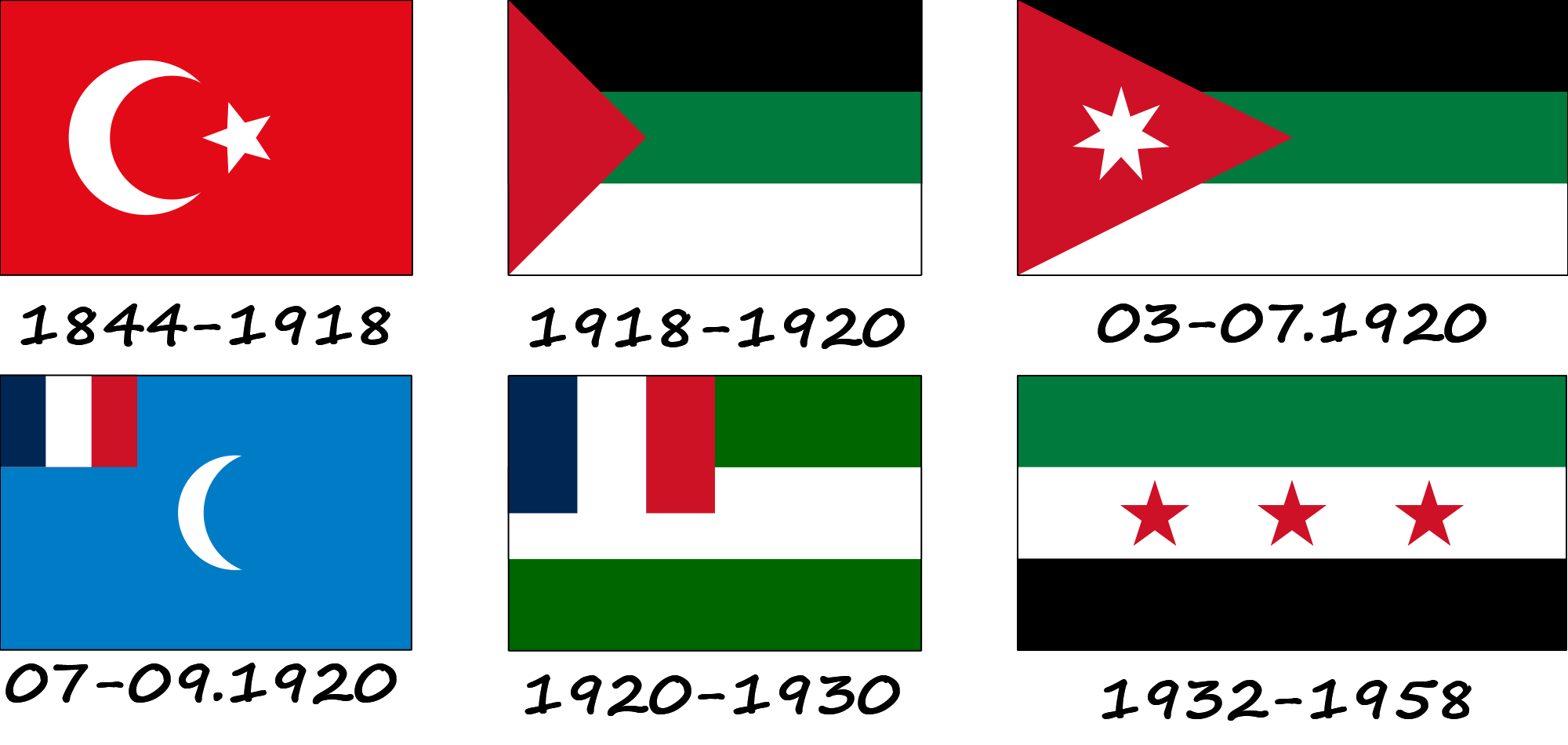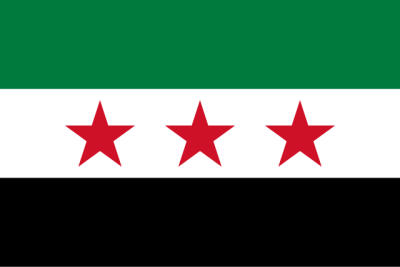The flag of the Ottoman Empire, a red field with a white sickle and star (the current flag of Turkey), remained the flag of Syria from 1844 until the last Ottoman troops left Damascus on September 30, 1918.
The Faisali flag is the flag of the Great Arab Revolt (1916-1918). It was adopted as the official flag of Syria by the Hashemite royal family. It became official on September 30, 1918, and remained so until March 8, 1920, when Faisal I became King of Syria and the country's independence from the Ottoman Empire was officially proclaimed.
The second Faisal flag remained official from March 8, 1920, until King Faisal's rule was overthrown on July 24, 1920, and replaced by the French Mandate regime. Later, it was adopted as the official flag of Jordan with a change in colors.
The flag of the Kingdom of the Syrian Arab Republic ceased to exist when the vanguard of Gouraud's troops entered the country on July 24, 1920, after the latter's victory in the Battle of Maysalun. The flag was abolished and a new flag was proclaimed, which was blue in color and contained a white crescent in the middle, and a miniature French flag in the upper corner. After the French entered the country, they issued a series of decrees that later became known as partition decrees. These decrees were issued by the commander of the French armies in the East, Henri Gouraud, between August 1920 and March 1921, ordering the division of the country under the pretext of a lack of harmony between the peoples.

The Syrian flag adopted on January 1, 1932, lasted the longest until Syria's union with Egypt in 1958. When the union was dissolved, this flag officially returned for a short period until the Baath Party came to power on March 8, 1963, with the flag's official age being 27 years. This flag was named the “Flag of Independence” because it marked Syria's liberation from the French mandate on April 17, 1946. The flag looked like this: its length was twice its width, and it was divided into three equal parallel stripes of green, white, and black, with the white part containing three red stars with five rays.

The flag of independence was replaced in April 1958 in addition to laws that stipulated the design of the Syrian flag at that time to create a greater Arab identity. The new flag took the red, white, and black colors from the colors of Arab unity, and the color of the stars on the flag was changed from red to green in honor of Syrian-Egyptian unity, as the two stars symbolize both Syria and Egypt.
In 1963, the Baathist governments of Syria and Iraq tried to create an alliance between Syria, Egypt and Iraq, but these attempts failed. However, both Syria and Iraq adopted a new flag to symbolize unity. This flag is identical to the flag of the United Arab Republic, except for the change in the number of stars from two to three. The three stars symbolize the unity of Egypt, Syria, and Iraq, as well as the goals of the Arab Socialist Ba'ath Party: unity, freedom, and socialism. In 1972, Syria joined the Union of Arab Republics along with Egypt and Libya, and adopted a new flag that replaced the stars with an eagle, symbolizing the tribe of the Prophet Muhammad, the Quraish. The union was dissolved in 1977, and Syria continued to use the union flag until 1980, when it was abolished and replaced by the previous two-star flag, which had been used from 1958 to 1961 to demonstrate commitment to Arab unity.
In November–December 2024, the Syrian Arab Republic underwent a dramatic political transformation that directly led to the replacement of the national flag. On November 27, 2024, a coalition of opposition forces led by Hayat Tahrir al-Sham (HTS) launched a lightning offensive against Bashar al-Assad's regime, which lasted only 11 days and ended with the capture of key cities, including Damascus on December 8. On the same day, the Syrian army acknowledged the president's overthrow, and Assad fled with his family to Moscow, where he received political asylum from Russia. This event ended the Assad family's 53-year rule and nearly six decades of Baathist domination, accompanied by civil war since 2011. Immediately afterwards, the opposition flag — a green, white and black tricolor with three red stars — was raised over government buildings in Syria and embassies abroad (notably in Moscow, Athens, and Madrid), where thousands of Syrians celebrated the end of the dictatorship by burning or trampling on the previous Baathist version. This flag became the de facto national symbol in December 2024 and was officially adopted in March 2025.

The return to the “flags of independence” (design from 1932–1958) had a profound symbolic and political meaning: it represented a break with the Assad regime, whose attributes were associated with repression, alliance with Egypt, and pan-Arab Baathism. The opposition chose this option back in 2011 as the emblem of the revolution to emphasize the desire for freedom, democracy, and national unity, countering the regime's propaganda, which accused it of colonialism. The three red stars on a white stripe represent the historical unity of Syria's three key regions — Aleppo, Damascus, and Deir ez-Zor — or the three anti-colonial uprisings against the French mandate (Ibrahim Hananu in the north, Sultan al-Atrash in the Druze Mountains, and Salih al-Ali in the Alawite region). The colors refer to Islamic history: green to the Rashidun Caliphate (hope and fertility), white to the Umayyads (peace and purity), and black to the Abbasids (the struggle against oppression). Thus, the new symbolism emphasizes a return to the roots of Syrian independence from France in 1946, promising a “new beginning” after decades of authoritarianism.








